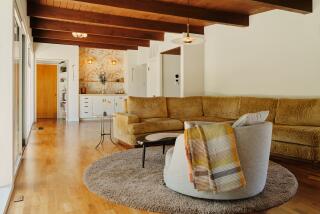Good-Humor Man : At Laguna Hills Seminars, Interior Designer Keeps Crowds in Stitches
- Share via
Theoretically, the lecture would be an hour long, the subject interior decorating and the audience attentive, note-taking, cowed. That was the plan, anyway.
What came to pass was a two-hour jam session of shoptalk, gossip and one-liners--a comedy routine by turns cocky and flirtatious that elicited wide-eyed adulation from listeners.
Such was the personal magnetism of Mario Buatta, a.k.a. The Prince of Chintz.
The New York-based Buatta came to town to deliver a seminar for local interior decorators at Design Center South in Laguna Hills. Even before he arrived--after spending a weekend in Morocco at the birthday party of one of his clients, Malcolm Forbes--Buatta’s high-profile name doubled the expected number of attendees, so a second lecture was added to the program. In all, nearly 500 designers--including dozens from outside the county and one from as far away as Telluride, Colo.--paid $10 each to hear Buatta’s talk.
By the look of the crowd pressing around him after each session, it was clear His Highness pleased the masses mightily.
Buatta is known for popularizing the English “country” look, replete with antiques, bushels of fresh flowers and acres of chintz. On this occasion, he jump-started his lectures in an Italian accent thick as pizza dough.
“Anyone take-a this course before? No? Good! OK, when I was-a little-a boy, my mama say, ‘Piccolo Mario, what-a you gonna be when you grow up?’ ”
In faux broken-English, a machine-gun stutter, Buatta laid out the possibilities, as his mama saw them: actor (“because-a you such a showoff”), psychiatrist (“because-a you crazy”) or lawyer (“because-a you talk-a so much”). He said he chose interior design because it would allow him to be all of the above.
“Any questions? Any answers?” Buatta asked, shifting to his normal cadences. “OK, who’s here today? All designers? So we can talk about clients, right? Tell all the deep, dark, secrets! Yes!”
One of the first “secrets” to emerge was that the man who grew up to design rooms filled with elaborate fine furnishings--rooms cushioned and draped in floral-patterned fabrics and accented with period bric-a-brac--grew up in an altogether different aesthetic environment. Interiors surrounding the child Mario were stark, modern and, as he saw it even then, cold and impersonal.
“You know, I grew up in a house that looked a lot like this room,” Buatta said, gesturing to the white-walled conference room. “In my mom’s house, you couldn’t walk on the carpet because you might leave footprints,” he said. “You couldn’t touch the table, because you might leave fingerprints. You couldn’t sit on the couch because you might leave fanny prints. One day I said, ‘Mom, why do we live like this?’ She said, ‘We’re expecting guests.’ ”
Although he spoke of his family home in Staten Island with humor, it made a lasting imprint on Buatta’s outlook toward interior design. Clutter and mess and personality are what make a house a home, he told his audience. Or, as he put it later, “your house should be a scrapbook of your life.”
In an interview after his lectures, Buatta rhapsodized about Southern California in general and Orange County in particular.
“I love the physical look here,” he said. “I love the look of the ocean and the line of the land along the shore. I loved (Orange County) from the first time I saw it 20 years ago, when it was just miles and miles of desert.”
Of current styles and trends, he said he thought the newly-rich-in-the-’80s folks have mostly missed the point.
“I’m tired of rooms that are self-conscious looking,” he said. “I see a lot of rooms that are filled with very expensive furnishings and all these other very expensive things just thrown together, and none of it has any character or history or personality. So much new money--they just don’t get the point of what it’s all about.”
During his lectures, Buatta showed a slide of an 18th-Century Sheraton writing box, which he described as “my first antique.”
Pictures of his own apartments through the years gave way to slides of clients’ homes and finally to the rooms he restored in the Blair House, the White House guest quarters. Buatta and East Coast society designer Mark Hampton were jointly commissioned for the restoration, which is nearing completion now and which earned the two designers a cover of Architectural Digest magazine earlier this year.
For the note-takers in the crowd, there were tips on such matters as lining curtains with merino wool, whether drapes can both “puddle” and “traverse” (yes), and how to preserve the pattern on delicate blue-and-white Chinese export porcelain (don’t dust it too often).
But mostly, the two seminars were brief encounters with an extroverted designer at the top of his field who calls his work, simply, “one American’s point of view on English decorating.”
Any questions? Any answers?






